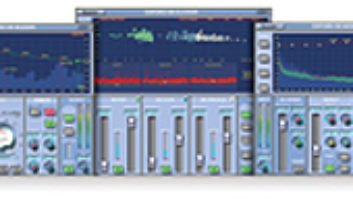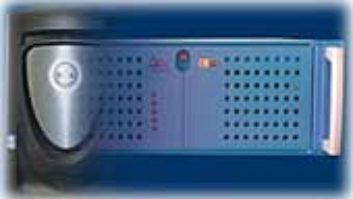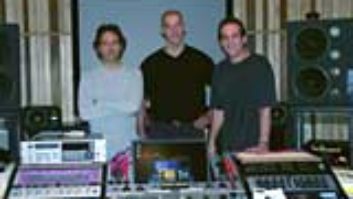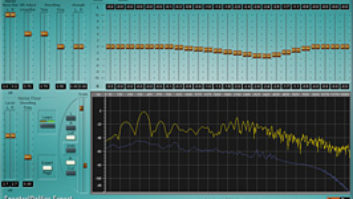AudioCube 5 is an advanced 24-bit/192kHz, integrated audio workstation for analysis, restoration, editing, archival, CD/DSD/SACD mastering and DVD-A authoring. A product resulting from a partnership between Germany-based Cube-Technologies and Canada’s Sascom Marketing, AudioCube 5 is an expandable, scalable, evolving system based on the PC platform. Audio- Cube 5 uses “off-the-shelf” nonproprietary hardware and runs Cube-Tec’s software. The system comes turnkey — configured, tested and optimized for your exact needs with the ability to grow via additional hardware/software components.
THE BASICS
The base system is offered in two ways: AudioCube 5-II, the original German-made “Blue Box” rackmount version; and the cost-effective AudioCube 5-D530 based on a Dell D530 workstation tower. Cube-Tec’s factory-installed hardware for either system includes one or more Merging Technologies’ Mykerinos boards and daughter cards; Cube-Tec serial I/O card/license module; SCSI controller; and dual monitor card. A basic AudioCube 5 comes with 24 channels of AES I/O that is expandable to 72 channels or 56/64 channels of MADI I/O using additional Mykerinos card sets. Both systems have dual 2.2GHz Intel Xeon microprocessors; 512MB RAM; ultrawide 160 SCSI; 18GB system drive and 36GB, 10k rpm audio drive (removable on the 5-II); 100Mbit Ethernet; integrated VITC and LTC connector; a combo CD-RW/DVD-RW drive; and FireWire and USB ports on the D530 system only.
Audio breakout boxes with eight, 16 or 24 channels of AES I/O plus wordclock and timecode I/O are offered for both systems. Hardware options include 56-/64-channel MADI, TDIF, SDIF and ADAT audio I/O; gigabit Ethernet; Sony 1610/1630 interface; and various archival/storage options.
For AD/DA conversion, Cube-Tec offers a line of 2-/4-channel ADCs and DACs. All are 24-bit/up to 96 kHz, and each have three sets of AES/EBU/S/PDIF/TosLink digital inputs/outputs, 115dBA dynamic range, sigma-delta conversion and balanced analog input/outputs. My demo sessions with AudioCube 5 used the Cube-Tec Model MDA-2-96, a 2-channel DAC with front panel source switching of eight different digital inputs, volume control and the ability to monitor summed mono, stereo and L/R channels separately.
THE SOFTWARE
AudioCube 5 runs under Windows 2000, pre-installed with the latest versions of Steinberg’s Nuendo (multitrack) and Wavelab (stereo). Merging Technologies’ Pyramix program is specified for DSD/SACD work. All systems have a CubeRescue CD-ROM to restore the system should the need arise.
All other Cube-Tec software is created by Houpert Digital Audio, which also develops software for SPL, Discreet, Apogee and Steinberg, among others. HDA writes two versions of some audio tools: a high-quality proprietary version called a Virtual Precision Instrument (VPI) and standard VST plug-ins for Steinberg. The AudioCube platform VPIs require dual processors and Cube-Tec’s hardware-licensing module to function. There are 36 VPIs available. After purchase, each is licensed and specifically registered to just one AudioCube 5; you cannot copy and use them on other systems — even another AudioCube 5. All analytical, restoration and mastering processors use up to 64-bit, floating-point arithmetic, which results in 52-bit resolution that is independent of audio level. This resolution is maintained throughout the system with batch files stored on the hard drive as 32-bit, floating-point files.
VIRTUAL-PRECISION INSTRUMENTS
The 36 VPIs are split between 30 stereo processors and six multichannel processors, including an 8-channel compressor, equalizer and a LFE-management tool. There are also Dolby AC3 encoding and decoding tools, as well as a .WAV-to-MLP (Meridian Lossless Packing) converter. To make difficult restoration decisions (such as whether to leave a sonic blemish in or remove it), the restoration VPI’s monitoring feature lets you hear the removed audio beforehand. A typical use is removing a patch of high noise floor that contains reverb tails or room ambience. Another application is handling analog tape print-through — a conundrum not yet easily solved by any software algorithm.
There are lots of slick VPIs, but two impressed me the most: The Azimuth VPI identifies and corrects L+R phase errors and panorama (pan) shifting to the resolution of 1/1,000 of a sample. To correct tape recordings where the record head’s azimuth, zenith, height or the tape path wavers randomly, Azimuth tracks this moving target as only a fast computer and smart software could.
NoiseDeModulator requires a 15-second sample from your audio file to learn and remove the amplitude and periodicity of a dynamic, heavily modulated noise. As far as I know, no other processor does this. Once amplitude and period are removed, the undesired noise — now in steady-state — is quickly excised using the DeNoiser or DeBuzz VPIs.
Cube-Tec’s CubeDVD-A authoring software was developed in conjunction with Nippon Columbia to create DVD-A masters. Presently, this is the only package that supports Version 1.2 of the DVD-A standard. CubeDVD-A can read audio files created in Nuendo without format conversion and encode a DVD-Audio disc according to CPPM Process 1 (Copy Protection for Pre-Recorded Media). DVD-9 dual layer, MLP encoding, SMART, 4C/Verance Watermark are all supported. The best feature of CubeDVD-A is called Proof, which allows any part or the entire DVD-A scenario — all links, commands, menus and slide shows — to be previewed without actually burning a DVD disc. DVD-A authors say that this feature alone would save them two-thirds of the time it takes to author a DVD.
With a system this deep, and because standards and practices are evolving around DVD and SACD production, company tech support is paramount. Cube-Tec uses NetSupport Manager from Productive Computer Software Ltd. and the Internet to diagnose your AudioCube system’s operation remotely. However, Internet access is not mandatory for complete tech support; Cube-Tec offers 24-hour phone numbers for emergency support.
QUADRIGA FOR ARCHIVAL
The final step, archiving, is accomplished by another Cube-Tec product called Quadriga. Quadriga uses the Audio- Cube platform for automated archival and quality control of all audio assets that you have restored and mastered. With complete database managerial software built in, Quadriga will run autonomously and (among many tasks) output a separate data file for music business personnel to access and review — without touching the archived audio files.
Simply, Quadriga converts all .WAV files into interim broadcast .WAV files (Broadcast Wave Format). After conversion or during capturing, these files are inspected to preserve and log the file’s title, archive number and BEXT chunk (Broadcast Extension, part of the BWF spec). Clicks, dropouts, clips, phase shift, average and maximum level, S/N ratio, etc., are also logged to establish a baseline quality reference. An entire family of software interfaces, editors, batch processors, file inspectors and legacy audio-carrier importation-control modules (tape, vinyl, cassette, CD, etc.) are offered to handle and completely automate any audio-archival task.
The Quadriga and AudioCube 5 systems provide serious tools for “start to finish” restoration, mastering and archiving. A basic AudioCube 5 system with several VPIs installed sells for under $20,000.
Cube-Tec, dist. by Sascom Marketing, 34 Nelson St., Oakville, Ontario, Canada L6L 3H6; 905/469-8080; fax 905/469-1129; www.sascom.com; www.cube-tec.com.
Barry Rudolph is an L.A.-based recording engineer. Visit him atwww.barryrudolph.com.
CUBE-TEC AUDIOCUBE 5 SOFTWARE
The system offers numerous VPI and software options. Here are a few, beginning with restoration tools.
DeNoiser is for broadband noise reduction of up to 20 dB. The noise floor is constantly analyzed, and a large filter is automatically created and shaped to the noise’s contour. DeClicker is an optimized click remover available in both VPI and plug-in versions. RepairFilter removes disturbances without altering the original audio. This VPI will track wow and flutter shifts. DeCrackler removes crackles from vinyl or shellac disc recordings and optical soundtracks. DeScratcher removes noises of up to 1,000 samples in length. DeClipper identifies and removes digital clips by automatically reconstructing their waveforms. DeBuzz removes steady-state buzzes and hum — including all harmonics — with an automatic notch filter. Azimuth identifies and corrects L+R phase errors and panorama (pan) shifting to 1/1000 of a sample.
DeMotorizer removes camcorder motor noise. SpectralDeHiss with Expert Page analyzes a fingerprint of noise but lets you edit parameters for more precision in difficult situations. NoiseDeModulator learns just 15 seconds anywhere in your audio and removes both amplitude and periodicity of a dynamic, heavily modulated noise. DePop removes optical-film soundtrack noises. Playback EQ emulates any of 20 different playback de-emphasis EQ curves. For the proper EQ playback and restoration of any sound carrier ever invented, the history of recorded sound is represented with preset curves like Blumlein, Decca 78, Columbia, RIAA or Westrex. Cube Waveform Restorer is a set of seven manual-wave interpolation algorithms.
Mastering VPIs include Loudness Maximizer to increase loudness without tonal changes; Spectralizer restores brilliance and transparency; Magneto analog tape compression/saturation emulation; FreeFilter, a 30-band, linear-phase, ⅓-octave equalizer that matches EQ curves from other audio sources, develops an overall EQ “shape” and applies it to new audio; DoubleRate to halve/double sample rates; AnalogEQ, a 7-band digital filter with analog filters emulation; FreeShaper is a dither applicator/noise shaper, with the choice of uncorrelated stereo dither or correlated mono dither; Automute mutes dither between songs where you do not want to add dithering noise; MultiComp is a 5-band mastering compressor; the DeES de-esser has both automatic and manual modes; and DynamicEQ is a dynamically modulated 3-band EQ.
DDP-Solution (Disc-Description Protocol) DVD-A premastering software is a separate software module available in AudioCube and freestanding versions. Available in AudioCube and freestanding versions, the CubeDVD-A authoring software provides DDP-Solution DDP (Disc-Description Protocol) premastering software.
The Stereo Analyzer Pack includes ZoomAnalyzer, SpectroGraph, MatrixScope and PhaseScope — a four-VPI bundle to help identify and monitor your audio.
All of the SurroundCube VPIs are available in both VPI and plug-in versions. LFE Divider and Merger are for LFE (Low-Frequency Effect) channel control and management; Ambience Eight is an 8-channel digital reverb; EQ Eight is an 8-channel mastering equalizer; and Loudness Maximizer Eight, Compression Eight and Magneto Eight are 8-channel versions of the stereo-mastering VPIs.
— Barry Rudolph






